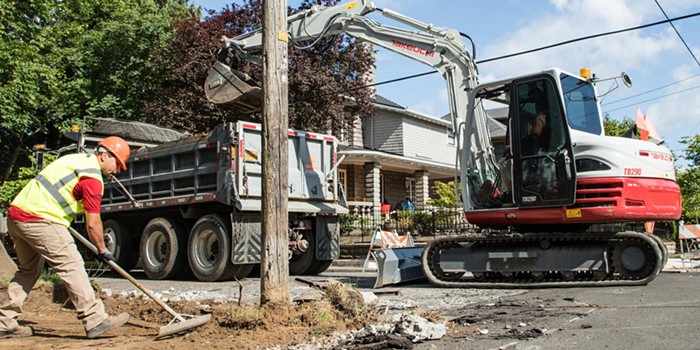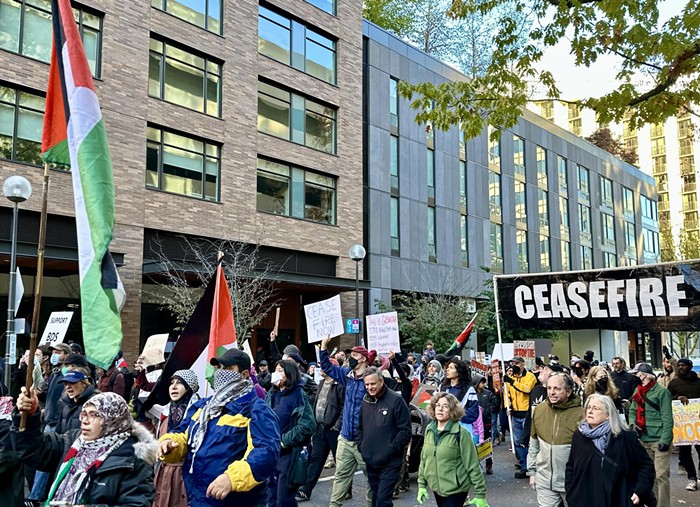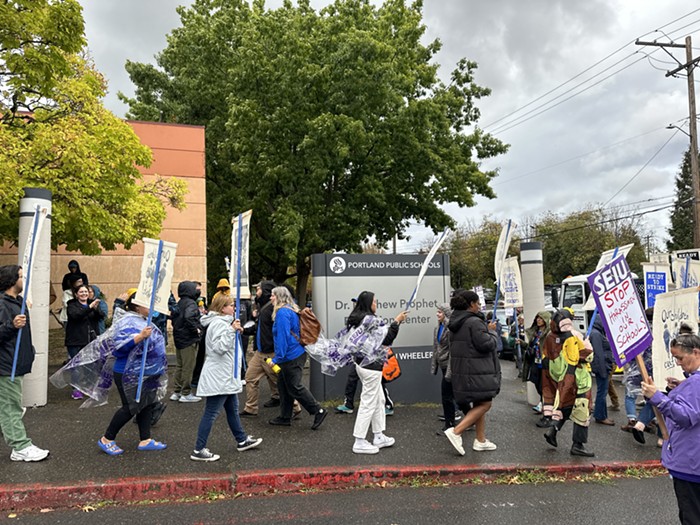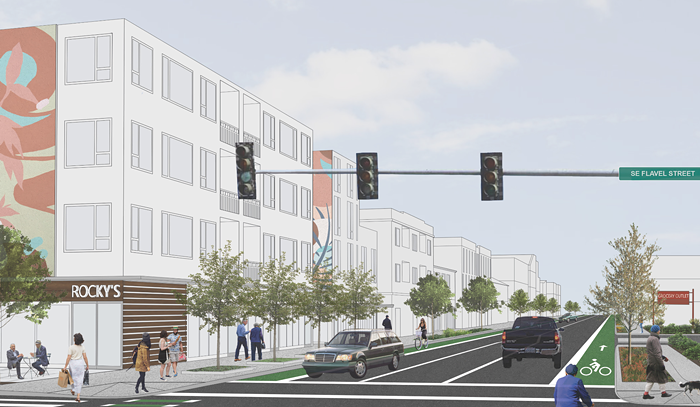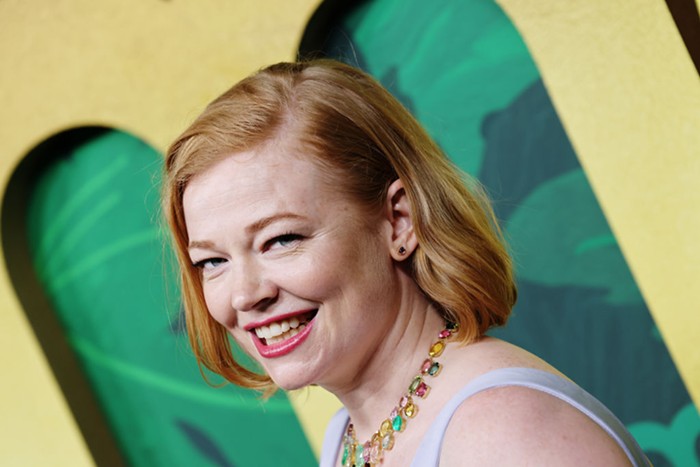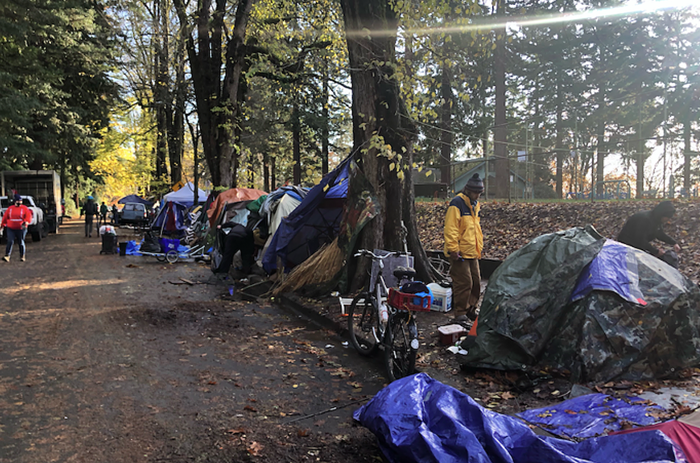Ten condominiums recently created in the building at 133 NW 18, formerly The Lawn, now renamed The George H. Williams Townhouse, are ready for sale. I've been in love with the building, which I'll always call The Lawn, since I rented a room in the '80s, when I was 19, working as a delivery driver for an art gallery and taking classes at PSU. Now, with the renovation, wiring is brought up to code and extensive dry rot repaired. The building has been made sound. Still, I can't help but sense that something important is lost in the transition from 32 apartments to 10 condominiums. I stopped by on a day when construction workers moved in and out of the building, their pickup truck backed over the curb to the front door. A model unit was finished and ready to show.
I've worked in real estate and I've taught at a university; I have every reason to expect to be taken seriously as a potential buyer. I should be more or less able to purchase a home. But when I dropped by to look at the building, wearing a J.C. Penny's "Big Mac" work coat and jeans, carrying a shady book called The Big Con, neither the realtor nor the architect gave me the time of day. Construction workers let me in.
HISTORY WORTH BEING HISTORY
I'm not the only former tenant to carry a torch for The Lawn. When it initially sold to developers, the first thing stolen was the sign off the front porch, which read, "The Lawn, Housekeeping Rooms, Sitting Rooms, Furnished Apartments." There's little value to the sign beyond nostalgia. We all wanted that sign. Portland's favorite street poet, Walt Curtis, is proud to claim he helped put the building on the state's historic registrar. More importantly, he helped put it on the state's creative map as the setting of his book, Mala Noche, which later became an early Gus VanSant film.
Curtis moved out around the same time I moved in. I rented a room on the second floor for $135 a month. More than once Walt Curtis startled me by climbing the building's fire escape--the fire escapes were infamous for reaching all the way to the sidewalk--to show a friend the room where he used to live, next to the room I was living in. The room was nothing to show off. It was a high-ceilinged space, with a window and a door. I questioned Walt's timing and approach, but never his motivation; The Lawn held that kind of draw, every corner significant and compelling.
Now, under "Our History," on the developer's brochure, following a paragraph about "Portland's most prominent citizen," George H. Williams (whoever he was), there's a leap in time, skipping the interesting years. After 1922, it says only, "...it became a well known haven for artists...1999 heralded a return to the original grandeur that the building deserved. A major renovation was necessary."
"Artists" is used loosely, perhaps euphemistically. Some tenants were artists, musicians and writers. Others were junkies. Some were both. The month I moved in, a tenant on the second floor died in his room of alcoholism. Shortly after, someone tried unsuccessfully to burn the building down, scorching a portion of siding below the manager's window.
OLD ROOMS REVISITED
The construction workers told me to go into the model unit if I wanted to find the realtor. They pointed toward a closed, white door, formerly saxophonist Christian Mulherin's room. Christian Mulherin currently lives and plays music in San Francisco. He tells me he still dreams about The Lawn, about living there, the twisting staircase and angled corners. He used to keep his rooms dark, halfway full to the ceiling with clothes and found objects.
When I entered his old room--now two apartments converted into one--everything was clean, sparse and freshly painted. Both the realtor and the architect were busy, talking and shuffling papers. These women probably aren't much older than I am, but they seemed older, with Nordstrom overcoats, designer scarves and harried cell phone conversations. After I caught their attention, spoke directly in the echoing space, one said, "If you want the realtor, that's her," and pointed to the other. The realtor said, "Just leaving," and waved as she stepped out the door.
I asked, "Are you showing the building?" But the realtor was gone.
The architect said, "Are you interested in buying?"
I told her I might be. She said, "Then you need the realtor."
I said, "Could I look around?"
The architect almost yelled as she answered: "No. I'd be here all day if I let everyone look. I'm going, you're going."
I grabbed a brochure off the granite counter before she hurried me out. The brochure is an expensive production in its own right; a small folded book printed on heavy cream-colored stock, with a set of four architectural drawings on transparent paper.
But the architect wasn't really leaving, didn't follow me out, and I lingered in the lobby, talking with the construction workers. I told one construction worker that I'd lived in the building, and he asked which years. When I said the '80s, he nodded and smiled. He said, "Yeah, then you've seen some things."
CREATIVE COMMUNITY, SURE... BUT WHO CLEANS THE TOILETS?
In retrospect, they don't all sound like good things, but somehow they were good at the time. There were nights I stood in the hall, in a robe, asking at the top of my lungs if all of Satyricon's after-hours party could quiet down. I had an art gallery to open the next morning, a van full of art to deliver and distribute; and then there were other nights when I joined the party, when somebody else was asking me to keep it quiet. There was an early morning when my then-boyfriend passed out in the building's only bathtub, and was pulled into my room by a neighbor we called The Cab Driver. One night I walked in my sleep and ended up in my neighbor Melissa's apartment. Another afternoon I woke up in my own room and found a pair of red shoes beside my bed, just my size. I never learned who came in while I slept, but wore those shoes for a year. There was a door spray painted in layers of endlessly swirling patterns, the smell of nag champa, oil paint and spray paint, pot and cigarettes, nightly poker games in the lobby, Mojave's door always open, and the couch where Mickey slept in the hall. For better or worse, the building was about community--with one bathtub, two showers and two toilets shared between 32 apartments, at least 50 people, how could the building not offer community?
But I have to question what I'm advocating: Is it necessary to share a single bathtub between so many to establish a sense of a creative community? The key, of course, isn't the shared bathrooms so much as it is the correspondingly cheap rent. Cheap rent, or some affordable way of living, is a fundamental element of being able to exist as a creative person in the developmental--active but not lucrative, experimental and necessary--stages of a career. Mortgage on a $400,000 condominium doesn't allow the same freedom and flexibility for creative trial and error as making a $100 rent payment.
MEMORY, DREAMS AND HARD ECONOMICS
Now, walking in the new, renovated version of the building feels like a dream. Some doors are where I remember them. Other doors are sealed over and are gone entirely. I walk in one apartment, and within steps, look out the windows of what should be a second apartment further down the hall. A stairway from the second to third floor is still standing but goes nowhere; it's sealed inside an apartment, a decorative element, and runs into a closed ceiling. Everything is both bigger and smaller than I remember it.
The once-wide communal hallways are oddly narrow. All communal spaces have receded, while the apartments themselves are combined and opened up. That's the key problem with gentrification: everything is increasingly private and economically precious, with less shared space. This is one very literal answer to the question of what's been lost when, in a boom economy, buildings are gentrified and re-marketed as upscale material: shared housing, rentals and communal areas are exchanged for sellable private property. In The Lawn, we used the communal spaces, and in that way cultivated a sense of community.
Later, when I mentioned the architectural changes to Tim Renner, a musician who used to practice in the basement, he said, "You can't sell a hallway." He's exactly right.
I asked him what he thought the benefits of a building like The Lawn were.
He said, "Cheap rent relieves the need to be constantly selling yourself in a big way. It allows room to work on something besides making money." He said, "But things change; new things develop."
I asked him what he thought was coming in to take the place of buildings lost to gentrification.
He said, "Another part of town, maybe. Gresham. Or North Portland, or Northeast."
He's more optimistic than I am. I can't imagine myself living in Gresham. North and Northeast are already rapidly upgrading. After working for two years as a mortgage underwriter, I've seen property values escalate all over town.
GOODBYE TO ALL THAT
The day I was in the building, I mentioned the basement's junkies, and one construction worker said, "That's the only way we were able to get a permit to call that living space--a history of people living there."
People sleeping on the pool table and in a storage room.
I know a man who moved into The Lawn in the '70s, when the rent jumped from $45 to $65 a month. Now, the ten condominium units are for sale for a collective price of over three million. A parking space is an additional twelve thousand, in a neighborhood where parking is technically still free. There are no shared bathrooms or even shared laundry facilities. There won't be a public box of cast-off clothes to trade freely anywhere in the building. Doors will be locked and nobody'll sleepwalk from one scene to the next.
When the architect came by and told me it was an insurance risk just to have me poking around, I was ready to go anyway. In truth, as a writer and a teacher, I couldn't afford one of the units in the George H. Williams Townhouses even if I wanted one, but I'm not sure I would want one. For me, The Lawn was about a time and a place, Portland in the '70s and '80s, when personal expression really could be valued more than money, and community went beyond a catch phrase on a developer's sales pitch. Now, with the walls painted a thick, uniform white and the rooms redone in an upscale version of Home Depot's conformity, I have to wonder about future tenants, people who'll pay a quarter to a half million dollars for a small, urban space. The $400,000 condominium on the third floor is already marked "sold." One of the basement, or garden level units, listed at $225,000, is sold too. It's clear that the party as so many of us knew it, in all its chaos, acceptance, and glory, is long over for life at The Lawn.
